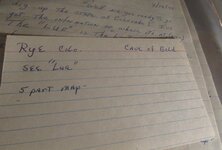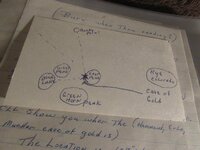PatrickD
Hero Member
- Jul 23, 2012
- 845
- 700
- Detector(s) used
- Garrett AT Pro
- Primary Interest:
- All Treasure Hunting
Thanks Patrick. I want to make sure I get this right, the Rye location was a potential target but there is nothing on the card saying the location was targeted because of a clue found on the LUE map?
You are asking me to remember stuff from when I was a kid. As I recall, these locations were deduced from the map quadrant. There is really only one section of the Sangre de Christos that match the mountain outline. Karl, my father and another friend claimed to have broken part of the code. Their process was rudimentary by today's standards and would be considered shallow and some guestimation in my opinion. It also involved a slide rule. (The slide rule and 3 X 5 cards are making me sentimental. Imagine what they could have done with the tools we have at our fingertips.)
I have a bunch of these 3 X 5 cards with notes and crude maps were drawn on. Others are just reference materials like how to research basic stuff way before we had google. There is also a bunch of letters with confidential conversations and stuff. I cannot speak to the validity of any of these leads. They might be worth following up on, they might be the result of incorrect analysis? You can judge for yourself as I don't have much else to go on except the front and back of the 3X5 card.


It was definitely associated with the LUE based on input from KVM and my father. I am pretty sure they did not make any recovery from this location.
Edit: Just noticed the letter in the background. Its in a binder of letters. I thought of posting some of KVMs letters up but there is so much that would have to be lined out due to inappropriate comments by today's standards. Every time I read any of his letters, I hear Archie Bunker. Great sense of humor and I thought it was funny how he referred to his wife as Broom Rider. He was also very generous with his expertise and knowledge. A great role model for treasure hunters. Just don't think certain comments would be acceptable according to TOS.
If anyone is actually researching this and needs to collaborate information, I can check through the stuff. Its what Randy does and it is what Karl would have done.
Patrick
Amazon Forum Fav 👍
Last edited:



 (Playing Beverly Hillbillies "theme song").
(Playing Beverly Hillbillies "theme song").
![IMG_1017[1].jpg IMG_1017[1].jpg](https://www.treasurenet.com/data/attachments/1267/1267770-7da102eb0512020a84827f2211fe2c3d.jpg)
![IMG_1018[1].jpg IMG_1018[1].jpg](https://www.treasurenet.com/data/attachments/1267/1267791-619fba0992f0eb308251c618aac4f722.jpg)
